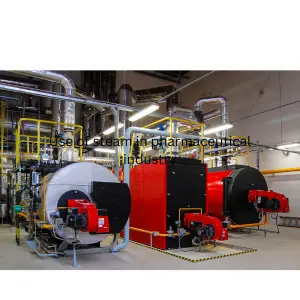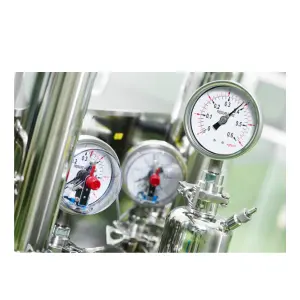Steam is an essential and critical utility, and various processes require the use of steam in pharmaceutical industry. It is mainly used to generate high temperatures in different pharma equipment such as in autoclaves and is an effective thermal energy source for various process requirements.
Use of steam in Pharmaceutical industry
Like all industries, steam is generated in equipment known as a boiler. In the boiler, water is heated at a high temperature to change its form into a gaseous state, called steam. Steam has the greatest thermal energy transfer ratio among all fluid forms, making it a powerful and efficient way of providing heat to various processes.
The use of steam in the pharmaceutical industry is sensitive because, for some processes, steam directly comes in direct contact with products and must follow regulatory and compliance requirements. Otherwise, it can damage or change the product characteristics, and pharma organizations can face regulatory action.
How steam is produced in pharmaceutical industry
Steam is generated by heating water to its boiling temperature, which converts it into steam. The quality and application of steam produced depends upon the type of water used.
In the pharma industry, there are mainly two steam-generating methods – Boilers and Steam generators.
Boilers
Boilers are industrial equipment used to generate steam from the water. The water goes into the boiler and passes through various stages to convert it into steam. Commonly, there are coal-fired steam, gas-fired, oil fuel steam boilers.
The steam produced by industrial boilers is not pure because chemical substances are added to feed water, to protect the internal parts of the boiler from corrosion and scale. The traces of these chemical substances are transferred to the steam from the feed water, making it unsuitable for pharma products and processes.
Steam Generator
A steam generator is a device used to generate clean steam in the pharma industry. It is much smaller in size and capacity and uses treated water, such as Purified Water, to generate steam.
The steam from the steam generator is pure and free from contamination and impurities and can be safely used for processes where the steam comes in direct contact with pharma products.
Types for the use of Steam in pharmaceutical industry
Let’s discuss some common types for the use of steam in pharmaceutical industry
Plant Steam or Raw Steam
Plant steam or raw Steam is generated from untreated or raw water in an industrial boiler. The Steam produced from raw water is used in applications that do not come in direct contact with the product and is mainly used in heat exchangers and HVAC applications.

In an industrial boiler, different chemical substances are added to protect the internal structure and parts of the boiler. Because untreated feed water can contain particles that can degrade the metallic parts of the boiler. When water is converted into Steam, traces of these chemicals are transferred into Steam, making it unable for processes and applications where Steam comes in direct contact with the products.
Chemical Free Steam
Chemical-free Steam is generated from treated water that does not contain any chemicals in it. However, this Steam cannot be used in applications that require direct product contact parts.
Pure or Clean Steam
Pure or Clean Steam is produced from treated water, having properties of drinking water such as USP purified or WFI. This water contains no external and harmful chemicals, so the Steam produced is also free from any chemical substances. Pure or Clean Steam can be used in processes that require Steam to come in direct contact with the product.
Pure or Clean Steam is produced in special equipment called a steam generator, which is smaller in size and capacity than the industrial boiler, and more importantly, its internal structure aids in generating contamination-free and compliant Steam for the pharmaceutical industry.
Process use of Steam in the pharmaceutical industry
Let’s look at some common use of Steam in the pharmaceutical industry
Sterilization
Sterilization removes harmful bacteria, microorganisms, and other contaminants at high temperatures from products and other items. Sterilization is performed in an equipment called an Autoclave. It is a closed and air-tight chamber where items to be sterilized are placed. Steam is used to generate high temperatures at high pressure, typically at 100°C or 121°C, depending upon the product.

Steam used in Autoclave is pure because Steam comes in direct contact with the product or items. As mentioned above, Steam is generated from a steam generator.
Manufacturing Process
Steam is used in the manufacturing process of pharma products, especially sterile products. It is used in various stages by injecting it into the vessel containing the product.
It is used as a part of formulation or to heat the chemical compound required for the reaction of chemicals in a product.
Steam Granulation
Steam is used as a binder to create granules in the granulation process. The Steam is sprayed into the equipment during the granulation process, which facilitates the granulation process.
Utility System
Steam is used in various sections of utility systems, such as the Air Handling Unit, to provide heat, which is part of equipment requirements.
Some tips for the effective use of Steam in the pharmaceutical industry
Like another utility system in the pharmaceutical industry, there are some careful considerations for Steam’s effective generation and distribution. Otherwise, Steam will lose its quality.
Let’s look at some of these tips
Materials of Construction
The material of construction for pipping, intermediate accessories, and other metallic parts should be SS316L because it resists corrosion and prevents contamination from attached piping. The metals must also be electro-polished with desired surface finishing.
Condensate
In the Steam, the condensate must be prevented and removed from the line. Because it causes water hammering and reduces the steam efficiency, and facilitates microorganisms’ growth.
Air
Air in the Steam must also be avoided because it reduces the steam efficiency.
Prevent Superheat phenomenon
Superheat occurs when the temperature of Steam becomes greater than the saturated Steam. It occurs when the steam pressure drops and its temperature increases.

